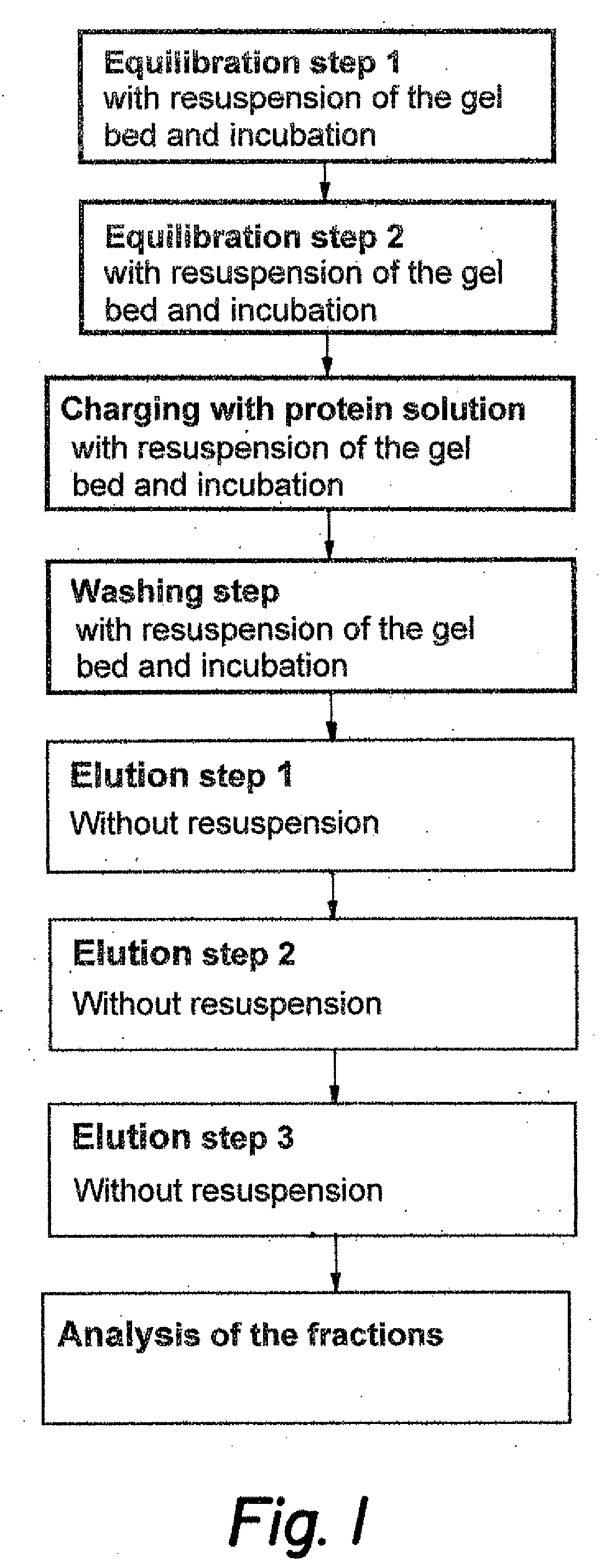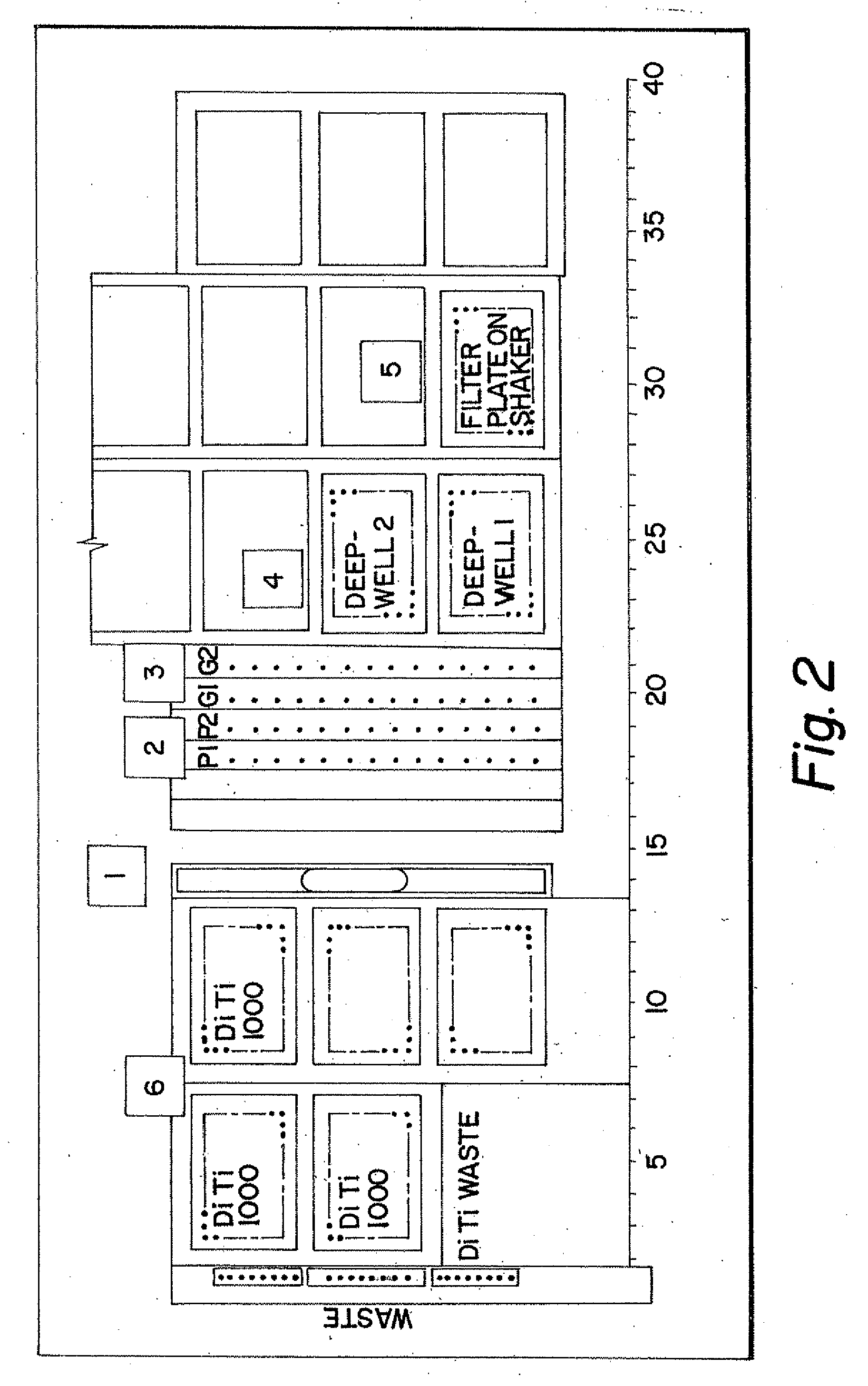Method for the Optimization of Chromatographic Purification Processes for Biological Molecules
a chromatographic purification and biological technology, applied in the direction of surface/boundary effect, component separation, water/sludge/sewage treatment, etc., can solve the problems of undesirable immunogenicity, host cell components may lead to allergic reactions or immunopathological effects, and the need for such biomolecules cannot be generally satisfied, so as to improve the purification process and improve the quality and economic viability of products. , the effect of improving the process
- Summary
- Abstract
- Description
- Claims
- Application Information
AI Technical Summary
Benefits of technology
Problems solved by technology
Method used
Image
Examples
example 1
General Instructions for Carrying Out the Process According to One Embodiment of the Invention (Automated Method in a Number of Parallel Test Batches
[0055] A multi-well filter plate is rinsed in a first step with 20% ethanol solution. To do this, the solution is poured into the plate and this is centrifuged, the ethanol solution thus centrifuged off being caught in a microtitre plate placed underneath and then discarded. The filter plate is then filled with the respective suspensions of the chromatography materials. If necessary, more 20% ethanol solution can be added to the suspensions. Centrifugation causes the material to be deposited and the liquid is eliminated to a point where the materials are not quite dry. The run-through is also discarded. Then equilibration of the chromatography material takes place (cf. also FIG. 1). For this purpose, buffer corresponding to the equilibration conditions is added to the chromatography material. Then the plate is incubated at maximum spee...
example 2
Comparison of Two Embodiments of the “Partial Batch Method” with a (Total) Batch Method
[0060] The partial batch method was compared with a batch method. In the latter, shaking and incubation are carried out in all the steps. In the partial batch method according to the invention, by contrast, the mixtures are shaken, incubated and centrifuged (or the supernatant is removed from the chromatography material in some other way) in the equilibration and charging steps, but in the elution steps centrifuging is carried out immediately (or the supernatant is removed from the chromatography material in some other way). According to one embodiment of the invention, shaking and incubation are also carried out during the washing step while according to a second embodiment the washing buffer is carefully applied during the washing step and immediately eliminated by centrifuging or by some other method.
[0061] In order to be able to judge which method gives the best indications of suitable chrom...
example 3
Use of the Process According to the Invention for Screening for Suitable Cation Exchanger Materials and Suitable Chromatography Conditions in the Purification of a Monoclonal Antibody
[0063] In the preparation of antibodies in eukaryotic cell cultures the target protein typically occurs as a protein secreted into the medium in a complex mixture with other biomolecules. For the monoclonal antibody mAb1 the following screening was carried out in order to determine optimum conditions for the enrichment of the antibody using a cation exchanger:
Binding Screening:
[0064] Two screening runs were used to determine the optimum chromatography materials and the ideal binding conditions (Binding screening). The following chromatography materials were tested: [0065] First run: SP Sepharose®, Toyopearl® SP 650 M, Toyopearl® SP 550 C, EMD Fractogel® SO3; [0066] Second run: CM Ceramic Hyper DLS®, S Ceramic Hyper DF®, Poros 50 HS®, CM Sepharose FF.
[0067] SP and HS here stand for the sulphopropyl ...
PUM
| Property | Measurement | Unit |
|---|---|---|
| volume | aaaaa | aaaaa |
| volume | aaaaa | aaaaa |
| gel bed volume | aaaaa | aaaaa |
Abstract
Description
Claims
Application Information
 Login to View More
Login to View More - R&D
- Intellectual Property
- Life Sciences
- Materials
- Tech Scout
- Unparalleled Data Quality
- Higher Quality Content
- 60% Fewer Hallucinations
Browse by: Latest US Patents, China's latest patents, Technical Efficacy Thesaurus, Application Domain, Technology Topic, Popular Technical Reports.
© 2025 PatSnap. All rights reserved.Legal|Privacy policy|Modern Slavery Act Transparency Statement|Sitemap|About US| Contact US: help@patsnap.com



